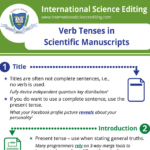An increasing number of agencies are using lottery systems to distribute research funding. Supporters of the approach have even suggested lotteries could be used by journals to select which papers to publish [1]. In this blog, we discuss how this would potentially work, and look at the pros and cons of such a system. How […]
Active versus passive voice in scientific writing (infographic)
In this infographic, we discuss the use of the active and passive voice in scientific writing. The infographic contains the following text: The active voice promotes simple, straightforward writing. As such, most scientific journals encourage the use of the active voice over the passive voice. Active voice – the subject acts. Passive voice – […]
How to write an introduction to a research report
In this blog, our guest blogger, Professor Emeritus Dolores Takemoto from Kansas State University discusses how to write an introduction. A thorough introduction is a necessary prerequisite for the most effective presentation of your research results. In addition, it optimizes your chances of getting your research report accepted for publication by a journal. Before you […]
Tips for writing sentences about science
Make your writing clear Say what you mean For example, the sentence The observed changes in the gut microbiota caused inflammation in the mice. suggests direct causation. However, if this was an observational study, the two outcomes were probably observed to occur together, but direct causation was not demonstrated. If so, the sentence should be […]
Verb tenses in scientific manuscripts (infographic)
A key aspect of producing a well-written scientific manuscript worthy of publication is the use of appropriate verb tenses in the different sections of the manuscript. In this infographic, we discuss when, where, and how to use the different verb tenses. The infographic contains the following text: Title Titles are often not complete sentences, i.e., […]





